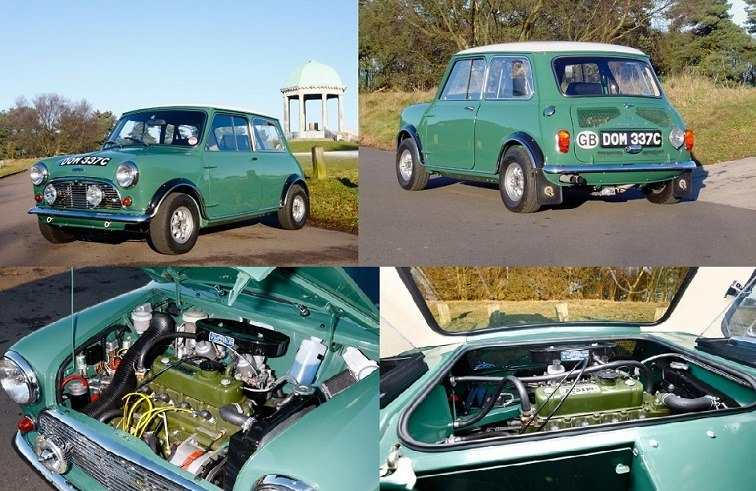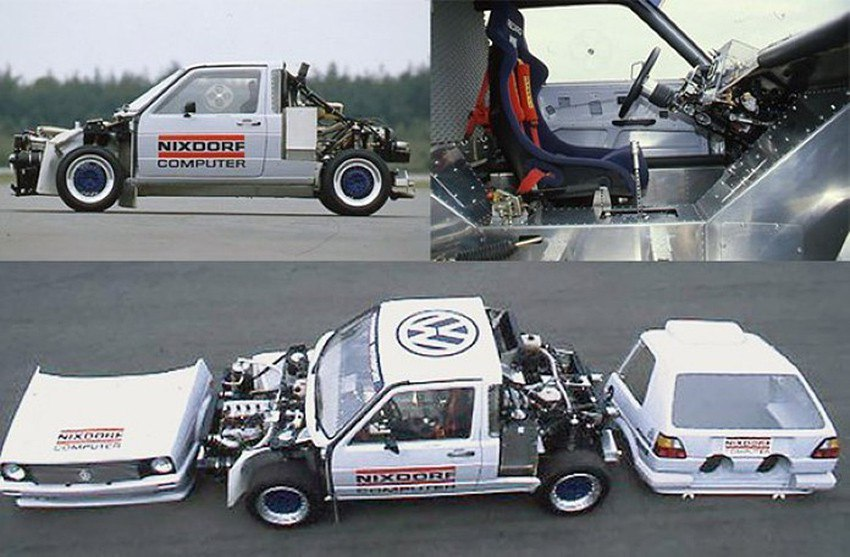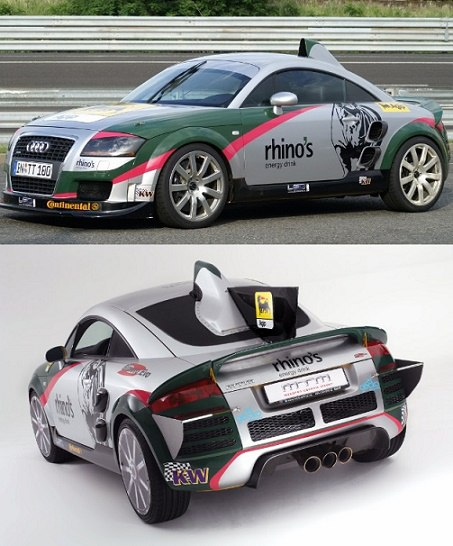
Duplication (from the French doubler to double) in the system is a type of redundancy with minimal redundancy.
The article the evolution of the development of automobile engines from the beginning of the 90s aroused interest, and a strong discussion of the transformations in the engine industry. This article will be its continuation without a time frame, but with one general condition - all the examples presented have increased reliability, and a number of other characteristics of the internal combustion engine for the better.
2 internal combustion engines in one car (all-wheel drive without complex transmission)
Usually, engineers have a difficult choice - which drive to choose? All-wheel drive will certainly be the ideal solution, but in addition to problems with weight distribution along the axes, additional difficulties arise due to the transmission. A simple solution to the problem is the decision to install two engines in a car.
The first production 2-motor cars appeared back in 1935.
The German company Vidal & Sohn Tempo-Werk GmbH, trying to win a military order, offered a simple and technological car called Tempo 1200G.
The number 1200 displayed the total volume of two two-stroke engines, and power up to 36 hp. Of the original solutions, in addition to the motors, it is worth noting two spare wheels located on the sides between the front and rear axles. This solution allowed the car to move on the road without the risk of damaging the bottom.
Serial production of the 1200G model continued until the 43rd year, but even after the production continued for the needs of other countries (Austria, Turkey, Finland, Romania, Bulgaria, Denmark).
The next two-engine is Citroen Sahara.
This car created on the basis of the legendary small car Citroen 2CV was the result of the struggle for oil contracts in Africa. A simple solution with two motors was liked by customers and as a result, from 1960 to 1966, 692 Citroen Sahara were built. The increased power and the choice between 3 types of drive on the machine were highly appreciated and ... now the price of these rarities is one of the highest among 2CV (from $ 100,000).
In addition to these two production cars, there were other twin-engine cars.

Mini Cooper Twini.

VW Golf II Pikes Peak

VW Scirocco 280/4

MTM TT Bimoto
Mercedes-Benz A38 AMG

Unstable on the moose test MB A-Class was a problem for the brand image.
The fact is that the car had too much “sailing” in relation to the mass, due to the peculiarities of the installation of the motor. AMG figured out how to solve this problem ... by installing a second engine from behind!
The A38 installed two engines from the A190 with a total capacity of 254 liters. from. and a moment of 360 Nm. With the help of such a power plant, the A38 began to gain 100 km / h in just 5.7 s, and the maximum speed reached 230 km / h. In addition, AMG specialists reduced clearance by 10 mm.
Interestingly, the rear engine is started separately from the front using a special switch built into the power window control unit.
2 turbines for internal combustion engines (only a few decades and already a standard solution)
Two turbines on a car are no longer surprising (some cars already have more), but still from the point of view of reliability this is one of the most acceptable solutions. Analogues of solving the inertia problem of a turbine like Twin-scroll and an electric turbine are not so simple yet, and often not always necessary.
The advantages of two turbines in the form of reducing the turbo-delay time, increasing power and efficiency over a wide range of engine speeds are well developed on ICEs of completely different purposes and volumes.
Initially, Twin Turbo (“twin turbines”) was called a technology in which exhaust gases were divided into two equal flows and distributed into two identical small turbines. This made it possible to obtain a better response time, and sometimes to simplify the design of the motor, using inexpensive turbochargers, which is very important for V-shaped engines with exhaust manifolds "down". Now the technology is somewhat more complicated and the two turbines are now of different sizes to ensure stable traction without a “turbo hole”.
The main advantage is the increase in power with relatively small dimensions of the internal combustion engine compared to the atmospheric version, however, also has its limits, but in many respects problems are associated with the next “doubling” of the number of turbines to four (“quad-turbo” from BMW).
2-mode inlet (variable geometry inlet). The problem of choosing between two "evils" is solved
No wonder many motorists compare the engine with the heart. The processes inside the ICE are very similar to the pulsating organ, as they also consist of a number of pulsations.
During engine operation, pulsations also occur in the intake manifold due to the cyclical nature of the air intake process and exhaust emissions. With a certain resonance of the movement of air waves inside the collector, this can even help fill the cylinder, but the problem is that this process only works on a certain speed range. All other pulsations above or below this bar harm the process of mixture formation in the internal combustion engine.
To solve this problem, they sometimes put a “long” intake manifold (if you need good traction at low revs), or “short” (for high revs). Of course, over time, engineers thought about “combining functions” in one device and created an intake manifold of variable geometry.
An analogy from biology.Variable length inlet is now used in both diesel and gasoline engines. Even in the WHA did this . In inflatable engines, the variable-length intake manifold is not used, as the required amount of air in the combustion chamber is provided by a mechanical supercharger or turbocharger.
The best example of “why is this necessary?” Is breathing while a person is running. At light loads, we prefer to breathe through the nose, but when there is not enough air we “suck” air through our mouth and nose (at critically high loads, only through our mouth).
2 to 4 valves (doubling)
By the number of valves per cylinder, few people are surprised now, but nevertheless this indicator once aroused interest among drivers of the 90s. Like any new technology in those days, it acquired a whole series of myths that have become obsolete in our time (of course, it is difficult to imagine a doubling of moving parts without accompanying problems, but in fact it turned out that way).
An increase in the number of valves reduces the weight of each of them, which means that the valves can move faster, creating less stress on the spring and seat. So, oddly enough, the seemingly more complex engine as a whole was more reliable than a similar 2-valve engine.
The topic of increasing the number of valves is also invariably associated with another type of “bifurcation” - the installation of two camshafts in the cylinder head of the engine.
2 camshafts (DOHC)

Engines with 2 camshafts received the designation DOHC (Double OverHead Camshaft) which literally means "double overhead camshaft." This design was widely used largely due to previous transformations in the internal combustion engine (an increase in speed that directly determined the introduction of more valves, electronic injection, etc.). For such operating conditions, simplicity and reliability of operation played a decisive role. Also, the “double camshaft” made it possible to more accurately set the timing of the timing, which increased power indicators due to a qualitatively improved mixing of the fuel mixture in the ICE cylinders.
So alteration of the cylinder head with 8 valve in 16 now does not present any special problems.
2-line timing chain

After the introduction of DOHC, the logical question became - how to set the camshafts in the cylinder head? Since earlier the drive was carried out by pushers (which was the reason for limiting the maximum engine speed), and now a similar method would nullify all the advantages of two camshafts and multi-valve. The solution was simple - either with a belt or a chain, and it is the choice of the chain in this case from the point of view of reliability that is the most optimal.
The most reliable drive is still considered a double-row chain. The service life of the chain coincides with the service life of the engine itself, and the two-row, for obvious reasons, is even more wear-resistant during operation. Over time, the truth is that the need for high reliability has disappeared, and at the moment, timing belts and a less reliable single-row chain are a more popular option.
Nowadays, there are examples of "tuning" of domestic equipment in the form of installing a 2-row chain on the Niva.
2-mass flywheel

The phrase two-mass flywheel at first glance still does not fit the definition of duplication, but like a variable-length inlet is essentially a combination of two contradictions.
The abbreviations DMM (two-mass flywheel), ZMS (Zweimassenschwungrad) and DMF (dual mass flywheel) designate the same product in three languages - a flywheel with two steel bodies movable relative to each other on one axis. Inside one of the cases is the heart of the mechanism - a damping mechanism and a bearing.
The basis of the idea of mass separation is getting rid of the resonance that occurs at certain engine speeds, and the need to get rid of torsional vibration dampers for which there simply was no room left. One way or another, resonance still manifests itself on motors with a lightweight and conventional flywheel, if there are no dampers of these oscillations. The transfer of the damping function of torsional vibrations to a two-mass flywheel made it possible to get rid of not only the danger of resonance in the engine, but also eliminated the same problem in the transmission.
The disadvantage of this combination in operation was the need to replace the DMM together with the clutch kit at the end of the service life, since the life of the two units is approximately the same. As a result, increased reliability and the ability to transfer higher peak loads of the DMM are not as noticeable to the consumer as the very fact of the need to replace this traditionally “eternal" part in a car.
In fact, the concept of reliability here should be taken not as a factor of an increased flywheel resource, but as the influence of the use of DMM on the overall reliability of the engine and transmission.
2 connecting rods for a round piston is better than 2 connecting rods for an oval like a Honda…
A very strange design with two connecting rods in the internal combustion engine was surprised twice.
The first, as is usually the case, was very surprised, but did not “take off”, and the second became more successful. Both times it was a motorcycle engine!
In 1977, Honda decided to radically change its position in motorsport by installing a four-stroke engine with 8 valves per cylinder and two connecting rods on a motorcycle. This decision was very difficult technically, but what can you do to win the race?
The test result showed that this design did not give a win and constantly broke.
The second successful two-piston engine was a twin-cylinder turbodiesel on a NEANDER 1400 TURBODIESEL motorcycle.

The number of innovations in the engine is huge, since it was originally planned to do it for performances on MotoGP, but then something went wrong ... and we got a unique diesel cruiser. In simplified terms, it sounds like this - in two cylinders along a piston that transmits torque to connecting rods connected to two crankshafts. Crankshafts are connected by gears and rotate in different directions. Such a design impulse made it possible to balance the lateral forces acting on the piston and install the pistons without “skirts”.
The main problem of motors - friction and wear losses in this case was solved by the balancing method, which allowed to reach 12 thousand revolutions already on the experimental design for MotoGP (on gasoline). Therefore, 4 - 4. 5 thousand revolutions for a diesel engine do not have a negative impact on the engine.
2 pistons per cylinder, or “opposite” on the contrary
A motor with oncoming piston movement or an engine with an opposing piston (MAP), contrary to its modern marketing prototype , nevertheless not only existed, but is still successfully operating.
The engines of this scheme are used in diesel locomotives, tanks, aircraft and shipbuilding.
The first MAP was built back in 1900 by Gobron-Brillié, and already in 1903 a car with this engine reached a speed of 100 mph! Further, a slightly redone French construction was already used in aviation by Junkers.
The diesel version of the MAP was built in Russia by engineer R.A. Korevo, and patented in 1907 in France.
A similar in philosophy to the RAP variant was also put on motorcycles.
2 nozzles per cylinder. Why complicate it?

Traditionally, when talking about the number of cylinders in the engine, it is believed that the number of nozzles is equal to this number. Why install more?
Of course, the complication of excess injection greatly affects reliability, when it comes to the injection of nitrous oxide, gas or even air. However, not everything is so simple, and the increase in the number of valves per cylinder as it turned out has its own negative effect ...
In internal combustion engines with the Dual Injector system, not one nozzle per cylinder, but two for each valve. Because of this, the diameter of fuel droplets entering the cylinder is reduced by 60%, so gasoline burns smoothly and stably, especially in combination with an automatic valve timing control system, Nissan experts explain. Fuel savings of 4% compared to direct injection engines.
The new technology is economical from all points of view: it is cheaper in production (a high pressure pump is not required), it weighs less, has a simple design and can reduce carbon dioxide emissions into the atmosphere. As noted by Nissan, this system is perfect for small engines, on which direct injection is too expensive and technically difficult to install.
Nissan's competitors in the land of the rising sun also created their own version of “2 nozzles per cylinder”, but with a more complex design.
So Lexus on the serial engine began to install the D-4S system - Direct Injection 4-stroke petrol Superior version, which combines the advantages of direct and conventional injection.
Hybrid injection due to various injection algorithms works either by using both injectors for injection, or only one (at revolutions above the average load). Thus, the resource of direct injection nozzles is saved and even fuel economy is achieved - environmental friendliness.
2 candles per cylinder. Sky Technology for Earth

When they say 2 candles per cylinder, they mean Twin Spark from Alfa Romeo.
For the first time, “2 candles” appeared on Alfa Romeo post-war racing engines as an adaptation of aviation technology for automotive engines. The solution, in addition to the obvious advantages, gave an unexpected problem in the first years of its use. The problem is that the increase in power due to better combustion added dynamics to the car, which created problems for handling. As a result, Italians in the mid-30s, due to the refinement of the engine, were forced to do serious research in the field of refinement of the chassis.
At the moment, Alfa Romeo is the only company that supplies all its motors with this technology.
PS - There are much more examples of duplication in a car. This is especially evident in the electronics of the car, and with the advent of unmanned technology such examples will become even greater. I have listed only the most basic ones that influenced the development of engine building in the same way as the introduction of duplication of processors on the growth of computing power of computers.